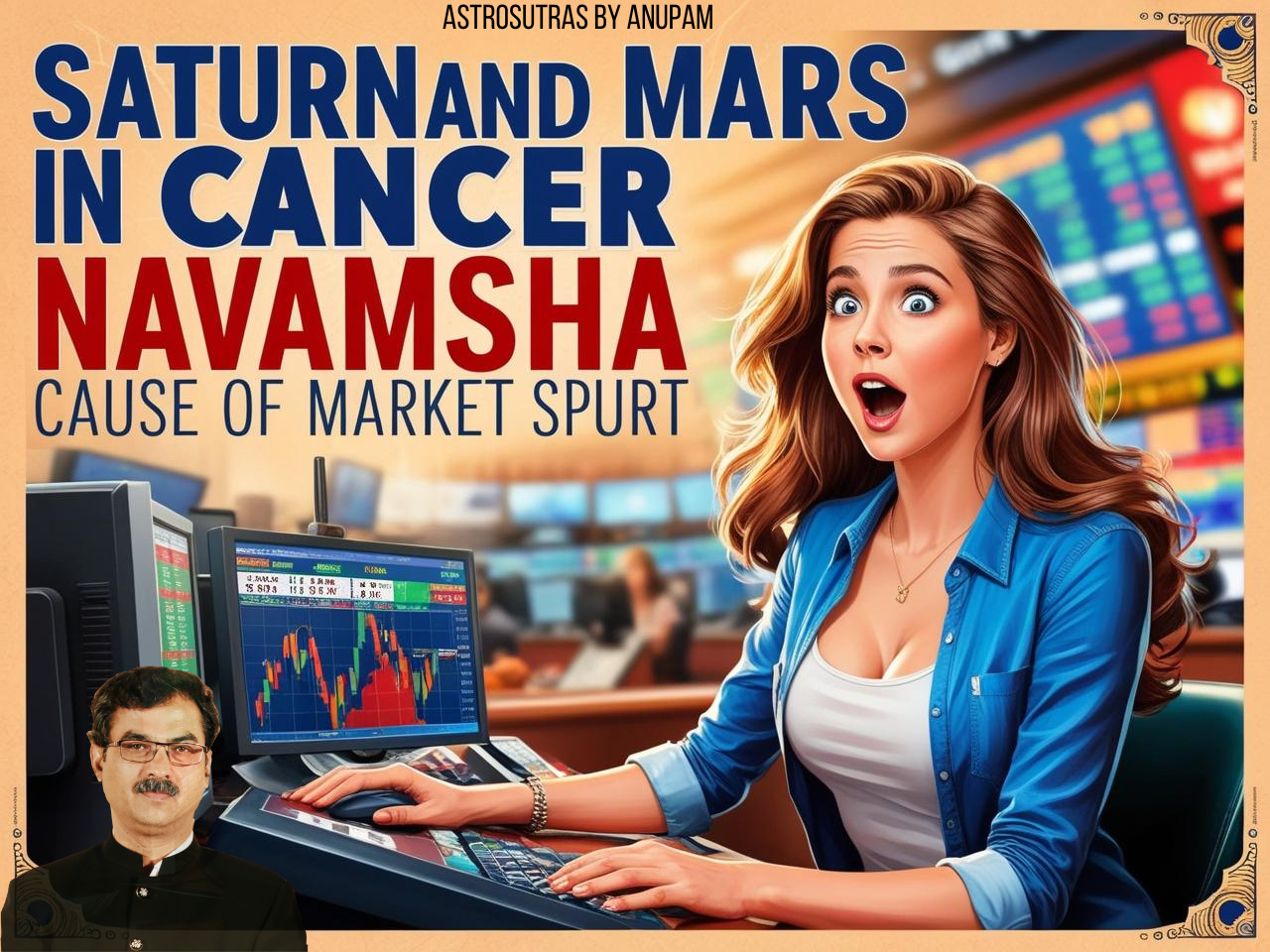Saturn and Mars in Cancer Navamsha – SPURT IN STOCK MARKET?
An Astrological-Academic Perspective

In recent times, global financial markets have exhibited a marked deep fluctuation, catching the attention of economists, investors, and astrologers alike. While the tangible factors—ranging from post-pandemic recovery to geopolitics and economic policy—have certainly contributed, it also invites an examination from the astrological lens, particularly considering the sensitive alignment of two key malefic planets: Saturn and Mars in Cancer Navamsha.
This essay explores a recurring astrological formulation rooted in traditional Jyotish principles that suggests a surge (spurṭ) in the stock market when Saturn and Mars simultaneously occupy the sign of Cancer in the Navamsha chart (D-9), especially when Saturn is also transiting in the nakshatra of Jupiter, such as Purva Bhadrapada in Pisces. This rare celestial configuration seems to coincide with short-term market optimism, but potentially paves the way for medium-term caution or even recessionary fears.
The Astrological Framework
In classical astrology, the Navamsha (D-9) is considered a vital varga (divisional chart) that reveals the underlying motivation and fructification strength of any planetary position in the birth chart. When Saturn, the planet of restriction, structure, and karma, joins Mars, the planet of energy, aggression, and impulsive drive, in the emotionally sensitive and Moon-ruled sign of Cancer, an interesting duality is formed.
- Cancer, being a watery and cardinal sign, is not a friendly terrain for either Mars (which is debilitated here) or Saturn (which is cold and rigid).
- However, when Mars and Saturn are both placed in Cancer in Navamsha, the energy becomes “compressed under emotional waters”—something akin to a pressure cooker, which, once released, creates a sudden burst.
This configuration has been noticed to trigger short-term speculative momentum, especially in equity markets. It is akin to suppressed volatility finding a directional bias, often upwards, under speculative optimism. The reasons for such a spurt could be psychological, as Cancer rules mass sentiment and Mars gives it action, while Saturn adds longevity or sustainability to that movement—at least temporarily.
Saturn in Pisces – Jupiter’s Influence and Economic Recalibration
Adding to this, the transit of Saturn in Pisces, especially when it resides in Jupiter’s nakshatra—Purva Bhadrapada, is astrologically significant. Pisces is ruled by Jupiter—the Karaka of expansion, economics, and wealth. Here, Saturn adopts a more philosophical, reflective, and restructuring role, often triggering global recalibration of economic systems.
Historically, such transits have coincided with 6-month market fluctuations, often accompanied by inflation concerns, commodity price variations, and fears of recession, especially when Saturn begins retrogression or conjoins major fixed stars or nodes.
Mars in Cancer – Impact on Commodities
Another layer to this analysis involves Mars in Cancer (whether in transit or D-9 placement), which has traditionally been linked to disruptions and surges in commodity markets. As Mars governs energy and metals, and Cancer rules agriculture and essential commodities:
- Gold and Silver often see sudden price movements due to shifts in emotional and financial security across the globe.
- Cereal prices and other agricultural produce may also show spikes due to Mars disturbing the stable nurturing aspect of Cancer.
- Mars here acts emotionally rather than rationally, which can be mirrored in the behavior of traders in commodity exchanges.
Correlation with Recent Market Trends
Looking back, during previous global tensions such as the U.S.-China tariff war, there was a significant Jupiterian dominance in the sky through its placement in Sagittarius and later Capricorn. The market’s reaction was a mix of optimism followed by corrective waves—mirroring the expansion-contraction rhythm governed by Jupiter-Saturn interplay.
In the current scenario, where we see Saturn transiting Pisces and Mars’s periodic Cancerian Navamsha activation, a similar script seems to be unfolding. While we’ve seen a strong rally in global indices recently (notably in the U.S., India, and select European markets), voices of caution are already rising concerning interest rate uncertainty, liquidity crunch, and potential earnings dips—all consistent with the “fear of recession ahead” highlighted in this astrological outlook.
Historical Data and Pattern Recognition
While hard quantitative correlation requires deep econometric and astro-statistical modeling, some qualitative observations are notable:
- In mid-2007, a similar configuration was witnessed when Mars was transiting Cancer while Saturn moved into Leo (close to Jupiterian nakshatras). Stock markets surged, only to see a massive correction by late 2008 (global financial crisis).
- In early 2020, just before the COVID-led crash, there were Mars-Saturn oppositions involving Cancer and Capricorn Navamsha combinations, reflecting nervous emotional sentiment under pressure.
- The current rally in 2025, marked by Saturn in Pisces and Mars’s periodic Cancerian Navamsha activation, is again offering a short-term euphoric run, with echoes of caution whispering in the background.
Conclusion
The astrological configuration of Saturn and Mars in Cancer Navamsha seems to have a tangible correlation with spurts in the stock market, especially under broader Jupiterian influence. It is a reflection of deep emotional undercurrents, karmic rebalancing, and speculative optimism playing out in financial domains. However, this alignment also hints at underlying instability, possibly leading to mid-term corrections, especially when Saturn begins its retrograde journey or shifts nakshatras.
In an interconnected global economy, where sentiment is as important as policy, such planetary alignments may indeed act as psychological triggers or subconscious influencers of collective behavior.
Disclaimer:
The views presented in this essay are entirely academic and based on classical astrological principles found in texts and practical case studies. They are not to be construed as financial advice. Readers are urged to consult certified financial professionals before making any investment decisions. This discussion is purely for the purpose of astrological exploration and intellectual engagement.

